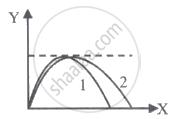Advertisements
Advertisements
प्रश्न
Show that the projection angle `theta_o` for a projectile launched from the origin is given by
`theta_o =tan^(-1) ((4h_m)/R)`
Where the symbols have their usual meaning
उत्तर १
Maximum vertical height `h_m = (v_o^2 sin^2theta)/2g` ...(i)
Horiaontal range `R = (v_o^2 sin 2theta)/g` .. (ii)
Solving equations (i) and (ii), we get:
`h_m/R = (sin^2 theta)/(2sin 2theta) = (sin^2theta)/(4sin theta cos theta) = sin theta/(4cos theta)`
`=>h_m/R = (Tan theta)/4`
`=> theta = Tan^(-1) ((4h_m)/R)`
उत्तर २
Since h_"max" = `(u^2sin^2theta)"/2g"`
and `R = (u^2sin 2theta)/g`
`=> h_"max"/R = (u^2sin^2theta"/2g")/(u^2sin 2theta"/g") = (tan theta)/4`
`=> (tan theta)/4 = h_"max"/R`
or `tan theta = (4h_"max")/R`
or `theta = tan^(-1)(4h_"max")/R`

APPEARS IN
संबंधित प्रश्न
The ceiling of a long hall is 25 m high. What is the maximum horizontal distance that a ball thrown with a speed of 40 m s–1 can go without hitting the ceiling of the hall?
A cricketer can throw a ball to a maximum horizontal distance of 100 m. How much high above the ground can the cricketer throw the same ball?
Show that for a projectile the angle between the velocity and the x-axis as a function of time is given by
`theta(t) =tan^(-1) ((v_(0y) - "gt")/v_(o x))`
A car starts from rest and accelerates at 5 m/s2. At t = 4 s, a ball is dropped out of a window by a person sitting in the car. What is the velocity and acceleration of the ball at t = 6 s? (Take g = 10 m/s2)
A boy travelling in an open car moving on a levelled road with constant speed tosses a ball vertically up in the air and catches it back. Sketch the motion of the ball as observed by a boy standing on the footpath. Give explanation to support your diagram.
A boy throws a ball in air at 60° to the horizontal along a road with a speed of 10 m/s (36 km/h). Another boy sitting in a passing by car observes the ball. Sketch the motion of the ball as observed by the boy in the car, if car has a speed of (18 km/h). Give explanation to support your diagram.
In dealing with motion of projectile in air, we ignore effect of air resistance on motion. This gives trajectory as a parabola as you have studied. What would the trajectory look like if air resistance is included? Sketch such a trajectory and explain why you have drawn it that way.
A cricket fielder can throw the cricket ball with a speed vo. If he throws the ball while running with speed u at an angle θ to the horizontal, find
- the effective angle to the horizontal at which the ball is projected in air as seen by a spectator.
- what will be time of flight?
- what is the distance (horizontal range) from the point of projection at which the ball will land?
- find θ at which he should throw the ball that would maximise the horizontal range as found in (iii).
- how does θ for maximum range change if u > vo, u = vo, u < vo?
- how does θ in (v) compare with that for u = 0 (i.e.45)?
A football is kicked into the air vertically upwards. What is its velocity at the highest point?
The trajectories of the two projectiles are shown in the figure. Let T1 and T2 be the time periods and u1 and u2 be their speeds of projection. Then ______.

